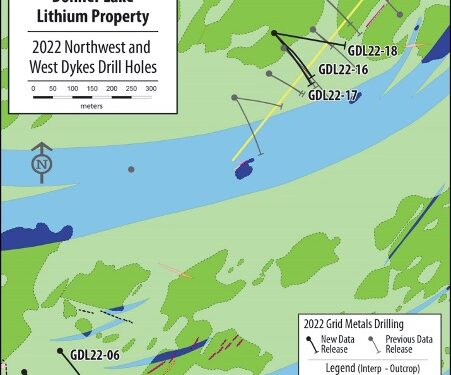Grid Metals Corp. (TSXV:GRDM) has received positive results from the final three holes completed in the Phase 1 drill programme at its Donner Lake lithium property in south-eastern Manitoba, Canada.
The company also revealed it has initiated certain project development activities including baseline environmental work and metallurgical testwork on both the Northwest and Main dykes. The property is located in the Winnipeg River pegmatite field, which hosts the world-class Tanco pegmatite and the associated Tanco lithium-cesium-tantalum mine and concentrator. The property is a 75%/25% joint venture between Grid Metals Corp and Lithium Royalty Corp., a leading player in global lithium finance.
Drilling Highlights:
- Results from the final three holes for the February-April 2022 Northwest Dyke drilling program include the following length-weighted average grades:
- 7.3 metres averaging 1.17% Li2O in GDL22-16 (from 239.9 metres) including 2.1 metres averaging 1.92% Li2O
- 5.5 metres averaging 1.49% Li2O in GDL22-17 (from 279.8 metres) including 3.0 metres averaging 2.41% Li2O
- 4.7 metres averaging 1.00% Li2O in GDL22-18 (from 227.0 metres) including 1.67 metres averaging 1.57% Li2O
Holes 16-18 were drilled to intersect the Northwest Dyke below previously reported drill holes, between 150 and 250 metres vertical depth. Note that the Northwest Dyke intersection lengths reported above do not represent the true thickness of the dyke, which is estimated to typically range from four to eight metres, representing 50-70% of the reported intersection lengths.
Complete analytical results for holes GDL22-16, -17 and -18, together with drill hole specifications for these and previously reported holes, are provided in the Appendices accompanying this release. Relative drill hole pierce points into the Northwest Dyke are shown on the accompanying longitudinal section.
Analysis: Phase 1 Drilling Results
The Northwest Dyke has now been traced by drilling for ~600 metres along strike and to a vertical depth of ~250 metres. Grid’s 2022 drilling was the first drilling completed at the Northwest Dyke since 1955.
The holes were drilled at an average of 100 to150 metre stepouts and demonstrated lateral and vertical continuity. As well the Northwest Dyke remains open to depth and along strike. A total of 15 holes successfully intersected the Northwest Dyke over a strike length of ~600 metres and vertical depths of 50 to 250 metres below surface.
Visual logging supported by whole-rock analytical data indicate that the Northwest Dyke is a zoned, LCT-type pegmatite dyke having a near-vertical orientation and showing very consistent Li2O, Ta2O5, Cs2O and Rb2O grades.
“The Phase 1 drilling programmr targeting the Northwest Dyke was very successful,” Carey Galeschuk, Grid’s Vice President, Lithium Exploration, said.
“The dyke shows good continuity, consistent mineralogical and grade variability, and a persistent spodumene-rich zone. Together with the Main Dyke we now have two clear targets for our initial near surface resource delineation drilling.
“As well, critical new exploration data is being acquired during the ongoing field campaign will provide the first property-scale information of the overall potential of the Donner Lake pegmatite field as numerous historically mapped pegmatites are presently being characterized to fully understand their lithium-bearing potential.”
The Northwest Dyke is the second drill-defined LCT type pegmatite with significant strike length on the Donner Lake property. Similar lithium grades were previously reported in the Company’s 2018 drill holes targeting the Main Dyke over a strike length of ~ 775 metres. The Main Dyke is located ~1.5 km to the east of the Northwest Dyke.
Future drill plans at the Main and Northwest Dykes will involve completing drilling over the known strike length of the two dykes to an approximate vertical depth of 300 metres to enable calculation of a 43-101 compliant mineral resource. It is expected that future resource drilling will be completed in conjunction with drilling of new exploration targets that are being generated from the current field programme. Timing of the drill schedule will be released at a later date.
Anomalous Lithium Intersected in the West Dykes
Two additional reconnaissance exploration holes (GDL22-05 and -06) were drilled on the West Dykes – a cluster of mapped pegmatites with very limited historical data. The West Dykes are located 500 metres to the southwest of the Northwest Dyke.
Both holes intersected multiple, narrow felsic dykes with one or more intervals of lithium-rich pegmatite including:
- 3.6 metres of 0.7% Li2O from 225.0 metres, including a maximum individual sample grade of 0.65 metres of 3.0% Li2O in hole GDL22-05
- 1.8 metres averaging >2.0% Li2O (over limit values reported) from 187.3 metres in hole GDL22-06
Ratios of Li-Ta-Cs-Rb are similar to those reported for the Northwest Dyke drill holes. The West Dykes are part of a mapped pegmatite system that has a strike length of ~ 800 m and is being mapped in detail and sampled as part of an ongoing field programme.
Update on Other Project Activities
New outcrop samples from the previously unsampled WE, Northeast, Cat Creek and North Creek Pegmatites, which are located in the eastern and northern portion of the Mayville Property, have been sent to Actlabs (Thunder Bay) for analysis. Initial results are expected within the next several weeks. As well, surface samples from the pegmatite characterisation program targeting the Main Dyke and West Dykes have also been sent to the lab.
The field program remains ongoing and is focused on sampling and mapping of pegmatite dykes on the property and developing a lithogeochemical anomaly map. Lithogeochemistry is an exploration technique whereby host rocks (rocks that can host pegmatites that may or may not be visible on surface) are sampled on a grid pattern to detect geochemical changes including enrichment in lithium that are generated by the injection of pegmatites into the overall geology of the area. It has been proven in many locations to be a powerful exploration tool in finding unexposed pegmatites.
For further information please visit: https://gridmetalscorp.com/










